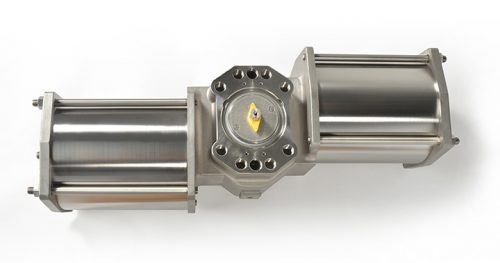Built to Last Due to our belief that actuators should not fail – all QTRCO actuators feature robust designs and premium materials
| QTRCO QS Series – Materials of Construction | |
| Mechanism | CF8M Stainless Steel |
| Housing | CF8M Stainless Steel |
| Cylinders | 316 Stainless Steel Optional: Amalga Composite or Aluminum |
| Pistons | CF8M Stainless Steel |
| Springs | Powder Coated Chrome-Silicon Steel Optional: Stainless Steel |
| Seals | BUNA Optional: Viton, Silicon |
Patented Rack & Gear® Actuator Mechanism
Offset cylinders align the piston axis with the pinion gear pitch circle diameter, eliminating the cantilever forces inherent in rack and pinion-type actuators. Low friction rollers maintain correct engagement of the stainless steel gearing for absolutely exceptional cycle life. The reduced friction enables outstanding throttling control as demonstrated in numerous ‘typical diaphragm actuator’ applications where corrosion or high vibration dictated a better solution.
QTRCO BI-DIRECTIONAL TRAVEL STOPS
QS actuators feature bi-directional travel stops which allow a minimum of 5 degrees of overtravel in each direction. The stops act on the piston motion and impart no side loading on the shaft.
NON-PRESSURIZED SHAFT SEALS CAN NOT FAIL (SPRING RETURN)
QS series spring return actuators apply no pressure to the shaft seals, eliminating a common cause of rack & pinion actuator failure.
PRESSURE BALANCED SHAFTS
While QS Series Double Acting actuators pressurize the shaft seals on the return stroke, we use a pressure-balanced shaft design that is not subject to the high “pistoning” forces seen in typical rack & pinion actuators. Unbalanced shafts lead to higher friction, torque loss, and early failure.
NON-EXISTENT ROD SEALS CAN NOT FAIL
Locating springs inward of the pistons applies pressure to the outer piston surface eliminating the need for rod seals on spring return actuators.
| QTRCO Q SERIES – RACK & GEAR® ACTUATOR | |
|---|---|
| DOUBLE ACTING | SPRING RETURN (SINGLE ACTING) |
| Torques to 21,000 in-lb | Torques to 7,500 in-lb |
| Pressure to 150 psig | Pressures to 150 psig |
| Temperatures from -60°F to +400°F | 90° Rotation (±5° at each end of travel) |



